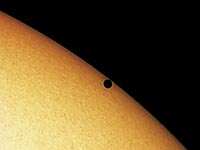Will Mercury and Venus ever transit the Sun simultaneously?
Yes, but this will not happen until AD 69,163.

A transit can take place only when Mercury or Venus is near an ascending or descending node, meaning a crossing point of its orbit on the plane of the ecliptic. For this reason, transits of Mercury currently occur only in early May or mid-November, and those of Venus in early June or early December. Astronomers have long known that the longitudes of the nodes of both planets are slowly increasing and that Mercury’s nodes will catch up to and pass those of Venus in about 11,000 years. But until quite recently no one knew whether a simultaneous transit would ever occur.
The question has finally been answered by Jean Meeus and Aldo Vitagliano in the June 2004 Journal of the British Astronomical Association. Their calculation involved a numerical integration of the motions of all major bodies of the solar system. In addition to the Mercury-Venus transit of July 26, 69,163, they find that a total eclipse of the Sun will take place during the Venus transit of April 5,
15,232. (These dates are expressed in Dynamical Time; exact dates will depend on the changing length of Earth’s day,which we can’t know in advance, and on whatever calendar adjustments our descendants might make.)
— Roger W. Sinnott
 0
0








Comments
You must be logged in to post a comment.